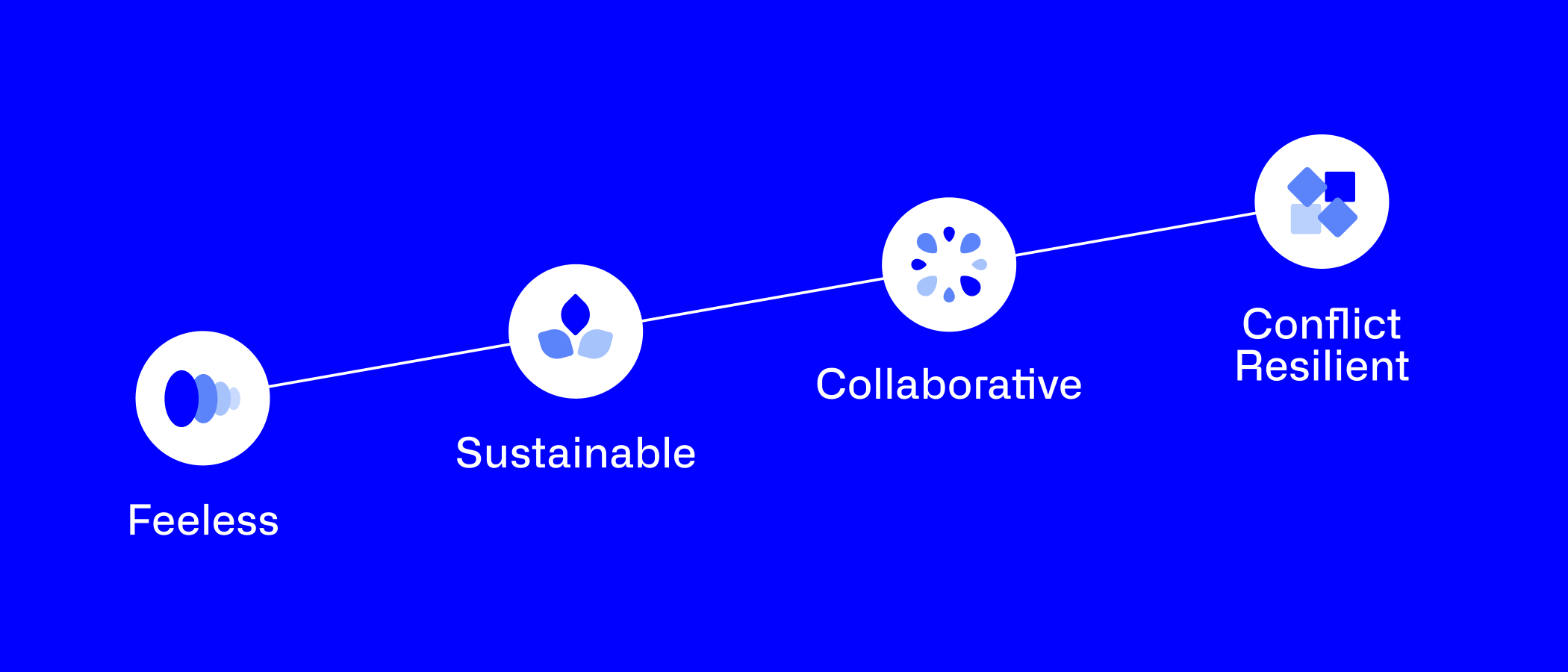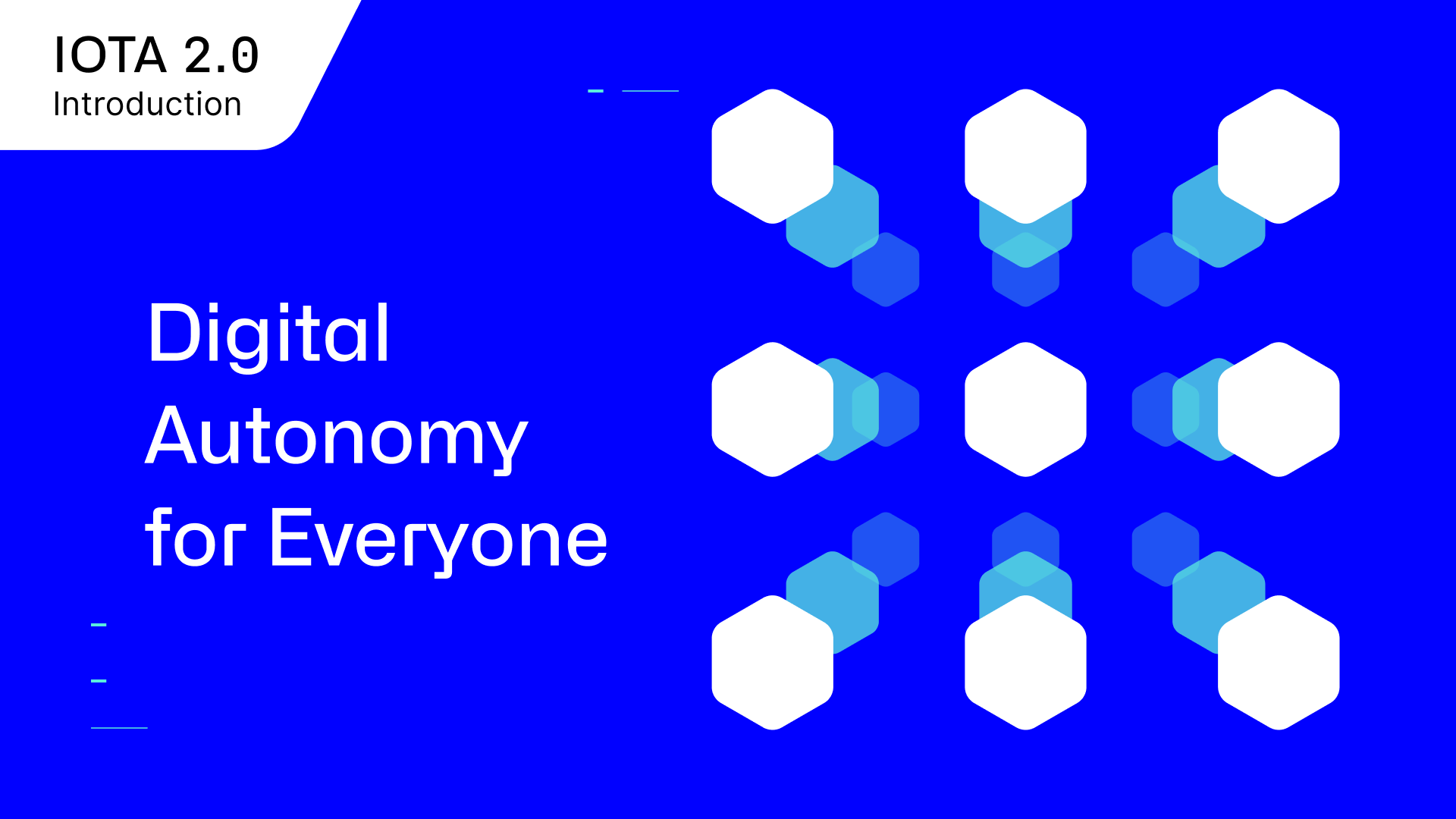Digital Autonomy for Everyone: The Future of IOTA
IOTA 2.0 Introduction Part 1
TL;DR:
This blog post is the first in a series that explains the IOTA 2.0 protocol update before it is introduced as a network. Join us as we forge a future where digital autonomy is not just an ideal, but a tangible reality. To achieve this reality, we need an infrastructure that enables it: That is what we are building with IOTA 2.0. With our research concluded and implementation well underway, the time has come to explain IOTA 2.0 in detail. Future blog posts, videos, and wiki articles will delve into the core principles and other aspects of IOTA 2.0, explaining its architecture and advantages.
In the realm of technical innovation, patience is a virtue.
After an extensive period of research and prototyping, the IOTA Foundation proudly presents IOTA 2.0, a protocol that encapsulates our vision of Digital Autonomy For Everyone.
The entire architecture of IOTA has been meticulously rebuilt from scratch, emerging as a resolute and robust system. This blog post is the first in a series of upcoming blog posts, wiki articles, and videos that will share with you the details of IOTA 2.0 in its entirety. Together they are blueprints for a future where everyone can enjoy digital autonomy.
For a more detailed take on this article, we recommend the Wiki version of this article.
Web2 and its Discontents
The internet has turned the world digital, overcoming physical barriers and borders and effectively turning the world into a global village. There’s no doubt that almost all aspects of our lives will eventually be digitized, one way or another, and that we'll need to safely navigate the digital world in order to interact with anyone else.
But among the convenience of Web2 (the current version of the internet), something vital is missing – trust, autonomy, and true equality. Web2 falls short of providing us with the freedom we yearn for. It fails to guarantee that anyone is who they say they are, and its centralized nature allows business and political powers to decide who can access and participate, leaving us vulnerable to manipulation, exclusion, and predatory value extraction. We can’t even interact with each other without going through siloed applications run by centralized service providers that extract as much profit – which is usually our data – as possible.
For these reasons and more, it's impossible for any profit-driven entity or state actor to establish a world-spanning network that is accepted, trusted, and used by everyone.
Such a system can only be established by someone or something free from profit-driven motives. The best candidate is distributed ledger technology (DLT). As long as they adhere to the core idea of what a DLT is supposed to be, DLTs are impartial, incorruptible, and unstoppable.
Digital Autonomy for Everyone
There have been incredible improvements in DLT since the early days of Bitcoin. Most notably, the initial notion of transacting monetary value peer-to-peer has advanced to transacting any form of data, making use of the same immutability and security guaranteed by DLT. In turn, anchoring data on a DLT has enabled smart contracts, which are securely and transparently stored and predictably executed on a DLT.
These two factors – immutability and smart contracts – are at the core of Web3. By using Web3, you can base actions and execute logic on immutable and therefore trustworthy information, creating a new form of interaction where you are in full control without having to rely on middlemen service providers. You can replace your siloed Web2 applications with interoperable decentralized applications. Additionally, you can exchange value using the same medium as the exchange of data, allowing for a powerful combination for the first time in the history of digitization.
In this new era, Web3 becomes a formidable challenger to the dominant extractive model of Web2. The centralized service providers, who once held sway over our data and resources, will find their grip loosened as we embrace a more equitable and interoperable system.
The IOTA Foundation envisions a future built upon a public, openly accessible, and interoperable DLT network – a world that fosters true autonomy, transparency, and safety for all. Our vision seeks to empower individuals to shape their destinies while retaining control over their data and assets – a vision we call "Digital Autonomy for Everyone.”
With the IOTA 2.0 protocol leading the way, the path towards this future begins to unfold. The long-awaited removal of the Coordinator heralds the dawn of true decentralization, paving the way for carefully balanced incentives and a level playing field for all participants.
Our Unique Value Propositions
IOTA 2.0 is an update of our innovative distributed ledger technology. At its heart remains the Tangle, our Directed Acyclic Graph (DAG) architecture where blocks are interconnected in a non-linear manner and confirm each other, unlike conventional blockchains that rely on miners and transaction fees. By combining unique value propositions (see below), IOTA 2.0 will be a decentralized, egalitarian, and sustainable DLT.
The most immediate way IOTA 2.0 will help deliver digital autonomy for everyone is through its innovative accounts system. Your account holds your IOTA tokens and generates Mana, a resource that grants system access. You can use your account to stake, delegate, claim rewards, and issue blocks. It’s a digital home to store assets, host digital identities, and build applications or smart contracts. The account is a decentralized part of the ledger and not registered with the IOTA Foundation or any other party. And thanks to the IOTA Identity Framework, accounts serve as a digital identity that is accessible, transparent, persistent, self-controlled, portable, and interoperable.
IOTA 2.0 also presents a unique set of value propositions that sets it apart from other DLTs and will empower you to live, work, and transact independently in the digital future:

- Feelessness for token holders: All users generate Mana by owning tokens. This is what ensures a share of the network's capacity, not paying fees out of the IOTA token. Also, issuing blocks doesn't incur a fee that diminishes token share; therefore, IOTA 2.0 prioritizes network utility and preserves the value of the IOTA token, rather than allowing third-party validators to extract value through fees without intending to use the network themselves.
- Sustainable utility-based tokenomics and incentives: IOTA 2.0’s tokenomics is a fair system that treats all participants equally, without differentiation between users and block producers. There is a fixed amount of IOTA tokens and by holding IOTA tokens you generate the Mana utility resource. Unlike other DLTs, IOTA 2.0 avoids dilution and inflation, preventing the compounding effect that enriches the already wealthy.
- Collaborative, asynchronous Nakamoto-based consensus: In IOTA 2.0, nodes can add blocks they learn about from their local copy of the Tangle, allowing real-time consensus to emerge without relying on periodic blocks as in traditional blockchains. This decentralized consensus process prevents anyone from having excessive control and censoring or manipulating information. Decisions made locally are relayed to all other nodes until all nodes in the network eventually know all changes made to the ledger.
- Reality-based conflict resolution: When using IOTA 2.0, you can enjoy continuous block processing, even during conflicts like attempted double-spends. When a conflict is detected, a node creates a local copy and tracks both potential versions of the truth. Transactions unrelated to the conflict are unaffected by the multiple realities created and the “useless” copy is dismissed once the truth is determined. This keeps ledger integrity intact throughout conflicts, allowing uninterrupted operations for all undisputed transactions.
Coming Up
After years of testing and iterative development, our updated, completely decentralized IOTA 2.0 network will be the very best implementation of a feeless distributed ledger based on a DAG.
The next blog post in this series outlines the five core principles underpinning the IOTA 2.0 distributed ledger. Once we’ve explained to you why we have built IOTA 2.0 and its purpose, we’ll dissect the architecture of the protocol, explaining how it works: from the underlying DAG structure to the node networking layer, the Tangle 2.0’s consensus mechanism, tokenomics, and incentives – always with you, the user, in mind and explaining what sets us apart from other DLTs.
And don't forget to look out for the Wiki version of this article for a more in-depth look at this topic.
Join the conversation on X
🌐 At #IOTA, we strive for a new era of #DigitalAutonomy. 🌐IOTA 2.0 introduces 4 unique value propositions that set it apart from other DLTs. Experience full control of our digital lives🧵⬇️https://t.co/V9lQRDpmYi
— IOTA (@iota) October 2, 2023
IOTA 2.0 Introduction
Part 1: Digital Autonomy for Everyone: The Future of IOTA
Part 2: Five Principles: The Fundamentals That Every DLT Needs
Part 3: Data Flow Explained: How Nodes Process Blocks
Part 4: Data Structures Explained: The Building Blocks that Make the Tangle
Part 5: Accounts, Tokens, Mana and Staking
Part 6: A New Consensus Model: Nakamoto Consensus on a DAG
Part 7: Confirming Blocks: How Validators Operate
Part 8: Congestion Control: Regulating Access in a Permissionless System
Part 9: Finality Explained: How Nodes Sync the Ledger
Part 10: An Obvious Choice: Why DAGs Over Blockchains?
Part 11: What Makes IOTA 2.0 Secure?
Part 12: Dynamic Availability: Protocol-Based Assurances
Part 13: Fair Tokenomics for all Token Holders
Part 14: UTXO vs Accounts: Merging the Best of Both Worlds
Part 15: No Mempool, No MEV: Protecting Users Against Value Extraction
Part 16: Accessible Writing: Lowering the Barriers to Entry




